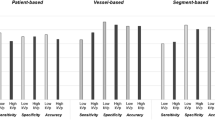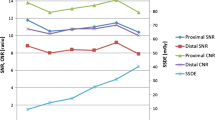Abstract
We evaluated the determinants of vessel contrast in prospectively ECG-triggered CT coronary angiography (CTCA). Seventy patients underwent low-dose CTCA using Body Mass Index (BMI)-adapted tube parameters and a fixed contrast material bolus. Contrast to noise ratio (CNR) was calculated from contrast (between coronaries and perivascular tissue) and image noise (standard deviation of aortic attenuation). Cardiac output (CO) was calculated from gated 99mTc-tetrofosmin-SPECT. Mean radiation dose was 2.13 ± 0.69 mSv. Image noise was not affected by BMI (r = 0.1, P = 0.36), while CNR was inversely related to body surface area (BSA) (r = −0.5, P < 0.001) and CO (r = −0.45, P < 0.001). After successfully overcoming the impact of BMI on image noise by adapting tube parameters, CNR mainly depends on coronary vessel contrast. The latter reflects the dilution of the contrast material by blood volume and CO, which are both correlated to BSA. Therefore, BSA adapted contrast administration may help to compensate for this effect.



Similar content being viewed by others
References
Leber AW, Knez A, von Ziegler F et al (2005) Quantification of obstructive and nonobstructive coronary lesions by 64-slice computed tomography: a comparative study with quantitative coronary angiography and intravascular ultrasound. J Am Coll Cardiol 46:147–154
Leschka S, Alkadhi H, Plass A et al (2005) Accuracy of MSCT coronary angiography with 64-slice technology: first experience. Eur Heart 26:1482–1487
Mollet NR, Cademartiri F, van Mieghem CA et al (2005) High-resolution spiral computed tomography coronary angiography in patients referred for diagnostic conventional coronary angiography. Circulation 112:2318–2323
Raff GL, Gallagher MJ, O’Neill WW et al (2005) Diagnostic accuracy of noninvasive coronary angiography using 64-slice spiral computed tomography. J Am Coll Cardiol 46:552–557
Husmann L, Valenta I, Gaemperli O et al (2008) Feasibility of low-dose coronary CT angiography: first experience with prospective ECG-gating. Eur Heart J 29:191–197
Hsieh J, Londt J, Vass M et al (2006) Step-and-shoot data acquisition and reconstruction for cardiac X-ray computed tomography. Med Phys 33:4236–4248
Hoffmann MH, Shi H, Manzke R et al (2005) Noninvasive coronary angiography with 16-detector row CT: effect of heart rate. Radiology 234:86–97
Pugliese F, Mollet NR, Runza G et al (2006) Diagnostic accuracy of non-invasive 64-slice CT coronary angiography in patients with stable angina pectoris. Eur Radiol 16:575–582
Bae KT, Seeck BA, Hildebolt CF et al (2008) Contrast enhancement in cardiovascular MDCT: effect of body weight, height, body surface area, body mass index, and obesity. AJR Am J Roentgenol 190:777–784
Husmann L, Leschka S, Boehm T et al (2006) Influence of body mass index on coronary artery opacification in 64-slice CT angiography. Rofo. 178:1007–1013
Stanford W, Burns TL, Thompson BH et al (2004) Influence of body size and section level on calcium phantom measurements at coronary artery calcium CT scanning. Radiology 230:198–205
Bae KT, Heiken JP, Brink JA (1998) Aortic and hepatic contrast medium enhancement at CT. Part II. Effect of reduced cardiac output in a porcine model. Radiology 207:657–662
Husmann L, Alkadhi H, Boehm T et al (2006) Influence of cardiac hemodynamic parameters on coronary artery opacification with 64-slice computed tomography. Eur Radiol 16:1111–1116
Sivit CJ, Taylor GA, Bulas DI et al (1992) Posttraumatic shock in children: CT findings associated with hemodynamic instability. Radiology 182:723–726
Motoyama S, Anno H, Sarai M et al (2008) Noninvasive coronary angiography with a prototype 256-row area detector computed tomography system: comparison with conventional invasive coronary angiography. J Am Coll Cardiol 51:773–775
Rybicki FJ, Otero HJ, Steigner ML et al (2008) Initial evaluation of coronary images from 320-detector row computed tomography. Int J Cardiovasc Imaging 24:535–546
Einstein AJ, Moser KW, Thompson RC et al (2007) Radiation dose to patients from cardiac diagnostic imaging. Circulation 116:1290–1305
Achenbach S, Giesler T, Ropers D et al (2003) Comparison of image quality in contrast-enhanced coronary-artery visualization by electron beam tomography and retrospectively electrocardiogram-gated multislice spiral computed tomography. Invest Radiol 38:119–128
Schepis T, Gaemperli O, Koepfli P et al (2007) Use of coronary calcium score scans from stand-alone multislice computed tomography for attenuation correction of myocardial perfusion SPECT. Eur J Nucl Med Mol Imaging 34:11–19
Acknowledgments
The study was supported by a grant from the Swiss National Science Foundation (SNSF-professorship grant No. PP00A-114706) and by the ZIHP (Zurich Center for Integrative Human Physiology, University of Zurich, Switzerland).
Author information
Authors and Affiliations
Corresponding author
Rights and permissions
About this article
Cite this article
Herzog, B.A., Husmann, L., Valenta, I. et al. Determinants of vessel contrast in BMI-adapted low dose CT coronary angiography with prospective ECG-triggering. Int J Cardiovasc Imaging 25, 625–630 (2009). https://doi.org/10.1007/s10554-009-9460-3
Received:
Accepted:
Published:
Issue Date:
DOI: https://doi.org/10.1007/s10554-009-9460-3




